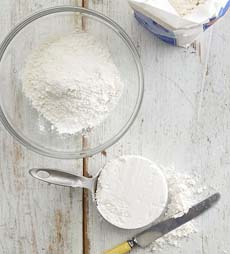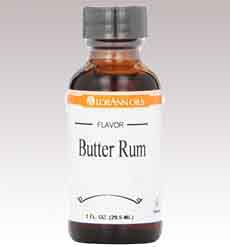TIP OF THE DAY: It’s Easy To Bake A Caribbean Rum Bundt Cake

[1] A rum cake bundt, heavy on the rum (photo courtesy King Arthur Flour). [2] The rum is poured onto the cake and sits overnight to sink in. This recipe adds cinnamon to the rum syrup (photo courtesy AlwaysOrderDessert.com). [3] Lots of rum syrup make this cake very moist (photo courtesy BrownEyedBaker.com). [4] This butter-rum oil (not rum extract) adds another layer of deliciousness (photo courtesy Lorann Oils). |
Rum cake is a year-round treat, but we tend to make them in the fall. They go well with a hot cup of tea, and are welcome gifts.
In the Caribbean, rum cakes are a traditional holiday dessert, descendants of figgy pudding and other Christmas puddings*. Rum cakes are descended from British holiday puddings, such as figgy pudding (plum pudding) and fruit cake. Traditionally, dried fruit is soaked in rum for months; but in modern recipes, just an overnight soak suffices. “If you’ve ever traveled to the Caribbean,” says King Arthur Flour, the premium baking ingredients company that sent us this recipe, “chances are you’ve had the amazing rum cakes that the islands are famous for. Sadly, these cakes are not often found in northern latitudes but this recipe is the closest we’ve ever had to the ‘real’ thing. “Yes, there is a lot of rum in this cake, definitely not for the faint of heart; but the texture and flavor are unbeatable—moist, rich and deeply satisfying. Whisk yourself away to white sandy beaches with this incredible cake.” Yes, this is definitely a potent cake (all real rum, no “rum flavor”), very moist and fragrant. If you have half an hour, whip one up. Prep time is 30 minutes to 40 minutes, bake time is 50 minutes to 55 minutes. In fact, make two: This cake freezes beautifully. Ingredients For 1 Large Bundt Cake 1. PREHEAT the oven to 325°F. Spray a 10 to 12 cup bundt pan with cooking spray. Sprinkle in the almond flour and turn the pan to coat evenly. Set aside. 2. PLACE all of the cake ingredients except the rum, vanilla and butter rum flavoring in the bowl of a stand mixer. Blend on medium speed for 2 minutes scraping down the bowl after one minute. 3. ADD the rum, vanilla and butter rum flavor to the batter and blend for another minute. Pour the batter into the prepared bundt pan and spread level with a spatula. |
|
|
4. BAKE the cake for 50 to 55 minutes. You may smell the nut flour toasting at first, especially that which is not covered by the cake batter. When done, the cake will test clean on a cake tester. Bundt cakes, much deeper than layer cakes, are difficult to test properly with a short toothpick. If you don’t have a 7-inch cake tester (or longer), try a piece of dry, uncooked spaghetti or linguine. Let the cake rest in the pan to cool slightly while you prepare the soaking syrup. 5. COMBINE the syrup ingredients, except the vanilla, in a medium-sized saucepan. Bring to a rapid boil; then reduce to a simmer and cook for 5 to 8 minutes, until the syrup thickens slightly. Remove from the heat and stir in the vanilla. 6. POKE holes all over the cake with a skewer. Pour about 1/4 of the syrup over the cake while still in the pan. Allow the syrup to soak in, then repeat again and again until all the syrup is used. Cover the pan loosely with plastic wrap and allow the cake to sit out overnight to soak in the syrup. When ready to serve… 7. LOOSEN the edges of the cake and invert it onto a serving plate. |
||
|
BLEACHED VERSUS UNBLEACHED FLOUR
Most serious bakers use unbleached flour, which is aged. But why did manufacturers start bleaching flour in the first place? Freshly-milled flour isn’t yet ready for baking. It improves with some aging. During aging, oxygen in the air reacts with the glutenin proteins, which eventually form gluten, to form even longer chains of gluten. These longer chains provide more elasticity and structure, the latter important for cakes. During this aging process—around four months—the fresh flour, which is slightly yellowish from carotenoid pigments in the endosperm, becomes paler as the pigments oxidize. This has no impact on the flavor or performance of the flour. Around the beginning of the 20th century, it became common for mills to use chemicals to speed up the aging process, producing more flour and requiring less storage space. Potassium bromate was commonly used, followed by bleaches like benzoil peroxide and chlorine dioxide, to approximate the whiteness of naturally aged flour. More recently, health concerns over the consumption of potassium bromate have led to its replacement with ascorbic acid. Here’s more about aged flour. |
 [5] Bleached and unbleached flour can be used interchangeably in many recipes, but cakes and some breads require the springiness provided by the longer gluten chains in unbleached flour. Here’s a further explanation from Better Homes & Gardens. |
|
|
________________ *Far from the creamy dessert puddings popular in the U.S., British puddings are cake-like, and can be baked, boiled or steamed. Savory puddings with meat were served as a main dish; sweet puddings evolved as desserts. In the 19th century, the boiled pudding evolved into today’s cake-like concept, such as the Christmas pudding that remains popular. While “pudding” is a generic term for dessert in the U.K., it has no relationship to the creamy milk-based American puddings. Here’s the difference. |
||


